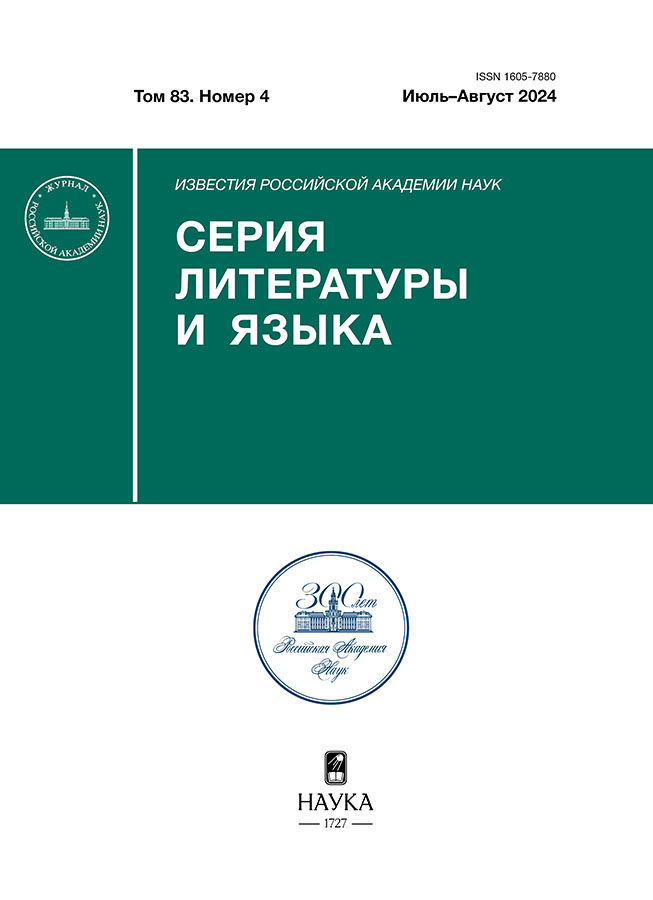Syntactic Opposition for Nouns and Verbs as an Argument of a Clause in Late Classical Chinese Text Lunheng I A. D.
- Authors: Durymanova A.D.1,2
-
Affiliations:
- Russian State University for the Humanities
- National Research University “Higher School of Economics”
- Issue: Vol 83, No 4 (2024)
- Pages: 74-85
- Section: Articles
- URL: https://rjonco.com/1605-7880/article/view/657013
- DOI: https://doi.org/10.31857/S1605788024040086
- ID: 657013
Cite item
Abstract
This article analyzes the syntactic features of presumably nominal and verbal lexemes in argument positions based on the material of a late classical text of the 1st century AD. “Lunheng”. The main proposed tool for syntactic analysis is a system of distinctive contexts (allow to determine the syntactic position of the lexeme under study). Such acriteriahelped to parse and analyze more than twenty-five thousand clauses. It appeared that there is a great frequency difference in the number of verb and noun lexemes encountered in given argument contexts (69.48% and 87.84%, respectively), there are also other differences in contexts’ frequency, conditions and restrictions of use. Potentially, these results may highlight some restrictions of free syntactic shift, and as a result indirectly indicate rigid flexibility of the system of categories in Old Chinese with a number of limitations.
Keywords
Full Text
About the authors
A. D. Durymanova
Russian State University for the Humanities; National Research University “Higher School of Economics”
Author for correspondence.
Email: durymanova.a.d@mail.ru
Lecturer at the Russian State University for the Humanities, Lecturer at the National Research University “Higher School of Economics”
Russian Federation, Moscow; MoscowReferences
- Zádrapa, L. Word-Class Flexibility in Classical Chinese. Leiden: Brill Academic Publishers, 2011. 256 p.
- Sun, L. Flexibility in the Parts-of-Speech System of Classical Chinese. Berlin: De Gruyter Mouton, 2020. 334 p.
- Bisang, W. Precategoriality and Argument Structure in Late Archaic Chinese. Constructional Approaches to Language. Amsterdam; Philadelphia: John Benjamin’s Publishing company, 2008b, pp. 55–88.
- Bisang, W. Precategoriality and Syntax-Based Parts of Speech: The Case of Late Archaic Chinese. Studies in Language. 2008, Vol. 32, pp. 568–589.
- Durymanova, A.D. Nouns and Verbsʼ Syntactic Shift: Some Evidences Against Old Chinese Parts-Of-Speech SystemʼS Flexibility (Analysis of Lunheng I A.D). 34th Paris Meeting on East Asian Linguistics. CRLAO, 2021, p. 22.
- Kryukov, M.V., Huang Shuin. Drevnekitajskij yazyk [Ancient Chinese]. Moscow: Main editorial office for oriental literature, 1978. 497 p. (In Russ.)
- Schuessler, A.A. Dictionary of Early Zhou Chinese. Honolulu: University of Hawaii press, 1987. 876 p.
- Croft, W. Parts of Speech as Language Universals and as Language-Particular Categories. Approaches to the Typology ot Word Classes. Vogel, Comrie (eds). Berlin: Mouton de Gruyter, 2000, pp. 65–102.
- Radford, A. Transformational Grammar: A First Course. Cambridge: Cambridge University Press, 1988, p. 640.
- Durymanova, A.D. Protivopostavlenie imen i glagolov v drevnekitajskom pamjatnike Lunheng I v. n.e. [Nouns and Verbs’ Opposition in Lunheng I A.D]. Thesis Synopsis. ... PhD. Russian State Uni. for the Humanities, 2021. 63 p. (In Russ.)
- Durymanova A.D. Funkciya argumentnogo distinktivnogo konteksta u 被 bej (na materiale kitajskogo pozdneklassicheskogo teksta “Lunhen”) [Argument Distinctive Context Functioning of 被bei (Based on the Material of the Late Classical Chinese Text – “Lunheng”)]. Vestnik Novosibirskogo gosudarstvennogo universiteta. Seriya: Istoriya, filologiya [Bulletin of the NSU. Series: History and Philology]. 2022, No. 21(4), pp. 114–127. (In Russ.)
- Big Chinese Dictionary. Sichuan: Sichuan cishuchubanshe, 1993. 2555 p. (In Chin.)
- Starostin, S.A. Zametki o drevnekitajskom yazyke [Ancient Chinese Notes]. Znak: Sb. st. po lingvistike, semiotike i poetike pamyati A.N. Zhurinskogo [Sign: Collection of Articles on Linguistics, Semiotics and Poetics in Memory of A.N. Zhurinsky]. Moscow, 1994, pp. 93–125. (In Russ.)
Supplementary files

















